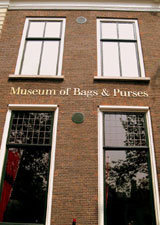AFP
Oct 31, 2007
The museum of 'It' bags
AFP
Oct 31, 2007
 Museum of Bags & Purses of Amsterdam |
With 3,500 bags, purses and accessories, the museum has the largest collection of its kind in the world and is a true Walhalla for leading designers as well as addicts of big bag names such as Louis Vuitton and Chanel.
But there is more to the collection than just marking passing fads, says museum director Sigrid Ivo, whose mother Hendrikje founded the museum.
"The history of the bag is not just a question of keeping track of a fashion accessory, it also shows what people needed to carry, how society changed, and how the role of women changed," she said.
From the Middle Ages to the late 17th century, men and women used small bags and purses worn in their belts to carry coins and papers. And the oldest bag in the museum is a man's 16th century goat-leather bag equipped with 18 different pockets hidden behind secret clasps.
When fashion changed in the 18th century from billowing skirts ideal for hiding pouches tied underneath around the waist, to more clingy empire-line dresses, women took to carrying purses instead in their hands.
The handbag was born.
"This is the first handbag my mother ever bought," said Ivo, pointing to a small German 1820s number in tortoise-shell inlaid with mother of pearl. That first bag triggered a 30-year-long passion that turned first into a private collection before Hendrikje Ivo 10 years ago converted part of her house on the outskirts of Amsterdam into a museum.
As the museum soon outgrew Ivo's house, the collection was moved to the centre of Amsterdam in a beautifully restored 17th-century canal-side house.
Intriguingly, early hand bags on show in the museum are all very small.
"Women really didn't have much to carry around," Ivo explained. Sewing-kits, coins, perhaps keys, but no make-up as this was improper for real ladies.
"The really big impulse came with the industrial revolution," Ivo said.
In the late 18th and early 19th century the Industrial Revolution brought new techniques that made new types of bags possible, while the advent of rail travel drove demand for hand luggage. Suddenly people were travelling more and women were leaving the house more often for social calls and shopping, and handbags became a necessary accessory.
"Leather bags became more popular because they were more durable and as travel opened up for the middle classes, souvenir bags also became popular," the museum director explained.
The museum for instance has a small 1838 beaded bag showing the Sirius, the first steamliner to cross the Atlantic ocean. A century later a special leather clutch bag in the shape of a boat commemorated the maiden voyage of the French Normandie steamliner.
In the 20th century, women's emancipation brought a greater diversity of handbags.
Leather briefcases for work, casual bags for daytime living, and in the evening, elegant shimmering clutch-bags. Timeless classics like the quilted Chanel purse and the Hermes Kelly bag took centre stage in the 1950s.
"In the last 20 years, fashion houses have turned to bags and perfume to make money. Now every designer is vying to produce the next "it" bag of the season. It's all about which star or model is seen with which bag," said Ivo.
Currently, instead of bringing in the latest big-name designer bag, the Amsterdam museum is seeking innovative design and new materials.
Ivo describes herself as a "hands-on" expert on bags.
"I have 60 myself, I like to change," she smiled.
After whetting the appetite of visitors with the collection, the museum offers a shop filled with unusual and stylish handbags as well as an online boutique as from next month for fashionistas unable to make the pilgrimage
www.tassenmuseum.nl
by Stephanie van den Berg
Copyright © 2024 AFP. All rights reserved. All information displayed in this section (dispatches, photographs, logos) are protected by intellectual property rights owned by Agence France-Presse. As a consequence you may not copy, reproduce, modify, transmit, publish, display or in any way commercially exploit any of the contents of this section without the prior written consent of Agence France-Presses.

























